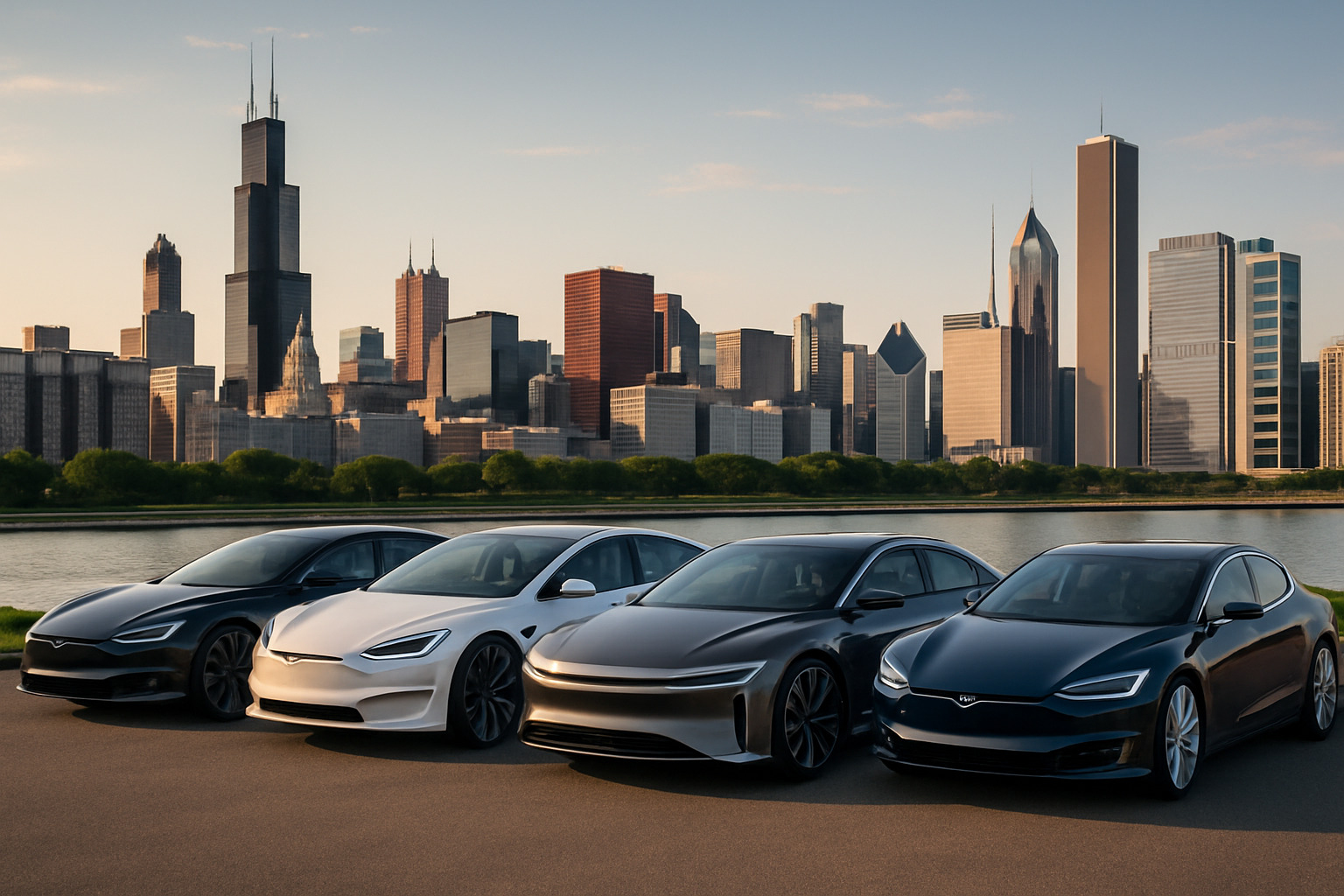Eco-friendly luxury cars: 10 Best Stunning Picks 2025
Why Eco-Friendly Luxury Cars Are Redefining Modern Opulence
Eco-friendly luxury cars are changing the automotive landscape by proving that sustainability and high-end performance can coexist beautifully. These vehicles combine zero-emission powertrains with premium materials, cutting-edge technology, and the refined driving experience that luxury buyers demand.
Top eco-friendly luxury cars include:
– Tesla Model S Plaid – 396-mile range, 1,020 hp, 0-60 in 1.99 seconds
– Lucid Air Dream Edition – 520-mile range, 1,111 hp, sustainable cabin materials
– Porsche Taycan Turbo S – 800V fast charging, 750 hp, track-ready performance
– BMW i7 – 387-mile range, theater screen, vegan leather options
– Mercedes-EQS – 0.20 drag coefficient, 350-mile range, HEPA air filtration
The luxury electric vehicle market was valued at $1.8 billion in 2022 and is growing at an impressive 17.7% annually. This rapid expansion reflects both advancing battery technology and changing consumer priorities toward environmental responsibility.
Modern eco-friendly luxury cars deliver on three key promises: zero tailpipe emissions, instant torque performance, and premium cabin experiences using sustainable materials like recycled fishing nets, vegan leather alternatives, and natural fiber composites.
Whether you’re drawn to the 512-mile range of the Lucid Air or the 22.5-minute fast charging of the Porsche Taycan, today’s sustainable speedsters prove that going green doesn’t mean giving up the thrill of driving.

Quick look at Eco-friendly luxury cars:
– Advanced car driving techniques
– Affordable luxury sports cars
– Best luxury sports cars
What Defines an Eco-Friendly Luxury Car?
When you shop for eco-friendly luxury cars, you 0 are buying more than an electric powertrain in a leather-lined shell. Genuine green luxury covers the entire product life cycle —from mining raw materials to recycling the battery pack decades later—and still delivers the serenity, tech and speed premium drivers demand.
Modern luxury automakers now:
– Power factories with 100 % renewables
– Recycle water and scrap metals on-site
– Publish transparent ESG reports so customers can track progress
The result? Cars that feel better and do better.
Instant torque has ended the performance debate; today ’s electric flagships out-accelerate V12 super sedans while their skateboard chassis open ups flat floors, panoramic roofs and whisper-quiet cabins trimmed in recycled fishing-net carpet, vegan leather and natural-fiber composites.
The global picture backs the trend. EV sales hit 6.6 million in 2021 and luxury marques led the surge, proving buyers will pay for speed and sustainability.
Beyond the Tailpipe: Total Carbon Footprint
Zero tailpipe emissions are only one piece of the puzzle. Ethical battery-mineral sourcing, closed-loop battery recycling and charging from clean grids matter just as much. As grid renewables grow, every mile in an electric luxury car gets cleaner automatically.
Credentials & Certifications to Watch
- EPA SmartWay – top 20 % lowest-emitting vehicles
- ISO 14001 – audited green manufacturing plants
- Carbon-neutral pledges – many brands commit to net-zero by 2030-2040
- Detailed ESG reporting – third-party-verifiable data, not marketing spin
Top Eco-Friendly Luxury Cars of 2024-2025

Today ’s eco-friendly luxury cars pair 300-520 mile ranges with sub-3-second launches and cabins crafted from sustainable materials. Below are the stand-outs buyers talk about most.

Flagship Electric Sedans
- Lucid Air Dream Edition – 520 mi range, space-age aerodynamics, recycled-material cabin.
- Tesla Model S Plaid – 1,020 hp, 1.99 s 0-60, over-the-air updates keep it fresh.
- BMW i7 – 387 mi range, rear-seat 8K theater, vegan leather options.
- Mercedes-Benz EQS – 0.20 Cd aerodynamics, dashboard-wide Hyperscreen, 350 mi range.
More insights on Electric Vehicles
Performance SUVs
- Rivian R1S – quad-motor 835 hp, 316 mi range, off-road “tank turn” party trick.
- Mercedes EQS SUV – 339 mi range, HEPA-filtered cabin, air suspension comfort.
- Polestar 3 – minimalist Scandinavian design, 517 hp, ~300 mi range.
Hybrid & Plug-in Icons
- Range Rover P400e – 31 mi electric only, 72 MPGe combined, ideal bridge tech.
- Lexus LS 500h – 28 mi electric range, 33 mpg highway, whisper-quiet flagship.
Whether you crave record-breaking range, silent limousine comfort or SUV versatility, 2024-2025 brings an electric luxury option to match.
Technology & Materials Powering Sustainable Luxury
The change happening inside eco-friendly luxury cars goes far deeper than swapping gas engines for electric motors. Today’s sustainable luxury vehicles represent a complete reimagining of what premium means, where recycled fishing nets become plush carpeting and plant-based materials deliver the tactile luxury that discerning buyers expect.
Weight matters enormously in electric vehicles, and manufacturers have finded that natural-fiber composites can slash interior panel weight by up to 50% compared to traditional materials. This isn’t just about extending range—lighter cars handle better, accelerate faster, and provide a more engaging driving experience overall.
The electrical architecture revolution centers around 800-volt systems that Porsche pioneered with the Taycan. These advanced systems enable the kind of ultra-fast charging that makes electric luxury cars practical for any lifestyle. When your Taycan Turbo S can charge from nearly empty to 80% capacity in just 22.5 minutes, range anxiety becomes a thing of the past.
Perhaps most exciting is how over-the-air software updates keep these vehicles fresh and improving throughout their ownership. Just like your smartphone gets better with updates, luxury EVs continuously receive new features, improved efficiency algorithms, and improved performance tuning—all delivered wirelessly while the car sits in your garage.
For deeper insights into how luxury automotive innovation is reshaping interiors, explore our coverage of Luxury Car Interiors.
The Rise of Circular Cabin Design
The future of luxury car interiors revolves around circular design principles—creating beautiful spaces from materials that can be endlessly recycled. Econyl yarn, spun from discarded fishing nets pulled from our oceans, now graces the floors of six-figure sedans with a plush feel that rivals any traditional luxury carpet.
BMW’s i7 showcases how recycled PET bottles can be transformed into interior panels that maintain the visual appeal and tactile quality expected in a premium vehicle. The magic happens through 3-D knitting techniques that create seat covers using exactly the amount of fabric needed—no waste, no compromise on comfort.
Vegan leather alternatives have evolved dramatically from the plasticky substitutes of the past. Today’s plant-based materials often feel indistinguishable from traditional leather while offering superior durability and easier maintenance. Many provide unique textures and colors that simply aren’t possible with animal-based materials.
The natural elements continue with plant-based vinyl and cork-based trim pieces that bring organic warmth to high-tech cabins. These materials reduce environmental impact while creating design opportunities that feel both luxurious and connected to nature.
Cutting-Edge Drivetrains & Charging
The next revolution brewing in luxury EV labs involves solid-state batteries that promise to make today’s impressive specs look modest. While still in development, this technology could deliver 10-minute charging sessions and 1,000-mile ranges within the next decade—completely eliminating any remaining barriers to electric luxury car adoption.
Current 350 kW DC fast charging stations already deliver remarkable convenience, adding 200 miles of range in just 12 minutes to vehicles like the Lucid Air. Plug-and-charge technology makes the experience seamless—simply connect the cable and charging begins automatically without fumbling for apps or payment cards.
Bidirectional charging capabilities transform luxury EVs into mobile power stations that can run your entire home for days during outages. Even more intriguing is vehicle-to-grid technology that allows owners to sell electricity back to utilities during peak demand periods, potentially generating income from their parked cars.
These advances in charging technology and energy management are turning eco-friendly luxury cars into sophisticated energy assets that contribute to grid stability while delivering the performance and convenience that luxury buyers demand.
Ownership Considerations: Range, Charging, Incentives & Costs

Range & Charging Reality
City driving often exceeds EPA estimates thanks to regenerative braking, while sustained 75 mph or freezing temps can trim 10-30 %. Ultra-fast 350 kW DC chargers and overnight Level 2 home units make top-ups painless; most owners wake to a full battery every morning.
Financial Perks & Incentives
- $7,500 federal tax credit (point-of-sale on qualifying models)
- State rebates (e.g., California up to $2,000)
- Utility cash for home chargers ($500-$1,000 common)
- HOV lane access in many regions
- Company-car Benefit-in-Kind rates as low as 2 %
Time-of-use electricity plans and workplace charging can slash fuel costs further.
Total Cost of Ownership
Fuel savings of $1,000–$2,000/yr, 40-60 % lower routine maintenance (no oil changes, fewer brake jobs) and 8-year/100 k-mile battery warranties offset higher purchase prices. Insurance can run 10-20 % higher, but green-vehicle discounts and shopping around help.
Use the SmartWay vehicle tool to compare models, and explore more tech details in our Luxury Car Technology guide.
Future Trends & Challenges in Sustainable Luxury Mobility
Solid-state batteries promise 1,000-mile ranges and sub-10-minute charging by the early 2030s. Hydrogen fuel-cell drivetrains are also resurfacing for large luxury vehicles needing rapid three-minute refuelling.
Autonomous “eco-chauffeur” modes could cut energy use 20-30 % by smoothing acceleration and selecting the most efficient routes, while vehicle-to-grid systems may let owners earn money selling stored energy back during peak demand.
Key problems remain: patchy rural charging, upfront price premiums and the need for large-scale battery recycling. Yet with governments phasing out combustion sales and buyers demanding transparency, the luxury segment is on a clear electric trajectory.
For deeper trend analysis, see our Luxury Car Trends for 2023 report.
Frequently Asked Questions About Eco-Friendly Luxury Cars
Are Eco-Friendly Luxury Cars slower than traditional performance models?
This is one of the biggest myths about eco-friendly luxury cars! The reality is quite the opposite—electric motors deliver something gasoline engines simply can’t: instant torque from the moment you press the pedal.
Take the Tesla Model S Plaid, which rockets from 0-60 mph in just 1.99 seconds. That’s faster than most supercars costing twice as much. The Lucid Air Dream Edition isn’t far behind at 2.5 seconds with its incredible 1,111 horsepower tri-motor setup.
What makes electric performance so special is the immediate power delivery. There’s no waiting for turbos to spool up or transmissions to find the right gear. When you want acceleration, it happens instantly and stays consistent throughout the entire speed range.
Many luxury EVs even include track modes that optimize everything from power delivery to suspension settings for serious performance driving. The Porsche Taycan Turbo S can handle multiple high-speed track sessions without the performance fade that often affects gasoline-powered cars.
How far can Eco-Friendly Luxury Cars travel on one charge?
Range anxiety is becoming a thing of the past with today’s eco-friendly luxury cars. Current models offer impressive distances, with the Lucid Air Dream Edition leading the pack at 520 miles per charge. Most luxury EVs now provide between 300-400 miles of range, which covers the vast majority of daily driving needs.
It’s worth understanding that real-world range can vary from the EPA estimates you see on stickers. Highway driving at 75+ mph, cold winter weather, and spirited driving can reduce range by 20-30%. However, city driving often exceeds EPA estimates thanks to regenerative braking that captures energy when you slow down.
The difference between WLTP and EPA testing can also create confusion, with WLTP often showing higher numbers. Always check which standard is being used when comparing vehicles.
Modern luxury EVs include sophisticated trip planning tools built right into their navigation systems. These automatically route you through charging stations and predict your battery level at each stop, making long-distance travel surprisingly straightforward.
Do insurance costs rise for electric luxury models?
Insurance for luxury EVs typically runs 10-20% higher than equivalent gasoline models, but there are good reasons and ways to manage this cost. The higher premiums reflect specialized parts, unique repair procedures, and often higher vehicle values.
However, many insurers now offer green vehicle discounts of 5-10% specifically for electric cars. Shopping around between different insurance companies can reveal significant differences in how they price EV coverage. Some insurers have acceptd electric vehicles more enthusiastically than others.
The advanced safety features that come standard in most luxury EVs work in your favor. Systems like automatic emergency braking, blind spot monitoring, and collision avoidance can qualify for additional safety discounts that help offset the base premium increase.
Usage-based insurance programs can be particularly beneficial for EV owners who drive fewer miles than average. Since many luxury EV owners use their cars for local driving and have other vehicles for long trips, these programs can provide meaningful savings.
The insurance landscape for electric vehicles is evolving rapidly as repair networks expand and insurers gain more experience with EV claims. The premium gap continues to narrow each year.
Conclusion
The world of eco-friendly luxury cars has reached a thrilling turning point where environmental responsibility and automotive excellence dance together in perfect harmony. These remarkable vehicles don’t just reduce emissions—they actually improve the luxury experience with their instant torque delivery, library-quiet cabins, and interiors that showcase the beauty of sustainable innovation.
Think about this incredible journey: we’ve gone from the pioneering Tesla Roadster to today’s Lucid Air with its jaw-dropping 520-mile range in just over a decade. That’s not just progress—that’s a complete change of what’s possible when brilliant engineering meets environmental consciousness.
The numbers tell an exciting story too. While traditional car sales struggle, luxury vehicle brands are growing at an impressive 8-14% annually. Affluent buyers aren’t just accepting this new paradigm of responsible performance—they’re actively seeking it out. There’s something deeply satisfying about experiencing that heart-pounding acceleration while knowing your tailpipe emissions are absolutely zero.
At Car News 4 You, we live at the exciting crossroads where automotive innovation meets sports culture passion. These sustainable speedsters represent everything we love about the future of high-performance driving. The adrenaline rush of instant electric torque combined with the peace of mind that comes from zero emissions? That’s the kind of win-win scenario that gets our engines revving.
Whether your heart races for the track-ready precision of the Porsche Taycan Turbo S, the presidential luxury of the BMW i7’s rear-seat theater experience, or the boundary-pushing range of the Lucid Air, today’s eco-friendly luxury cars deliver options that would have seemed like science fiction just a few years ago.
But here’s the really exciting part—we’re just getting started. The current generation of sustainable luxury vehicles is impressive, but the horizon holds even more promise. Solid-state batteries will slash charging times to minutes rather than hours. Autonomous driving will optimize every mile for maximum efficiency. Vehicle-to-grid technology will turn your car into a mobile power station that can actually earn money while parked.
The change happening in luxury automotive right now feels like watching the future unfold in real time. Every new model pushes boundaries further, every software update adds capabilities, and every charging station built makes the electric lifestyle more convenient.
Ready to dive deeper into this fascinating world of sustainable luxury? Our Luxury category hub is packed with the latest insights, reviews, and trends that are shaping tomorrow’s automotive landscape. Because at Car News 4 You, we believe the best driving experiences happen when cutting-edge performance meets environmental responsibility.








1 thought on “Sustainable Speedsters: Best Eco-Friendly Luxury Cars”
Pingback: Everything You Need to Know About Luxury Sports Car Reviews - Car News 4 You
Comments are closed.